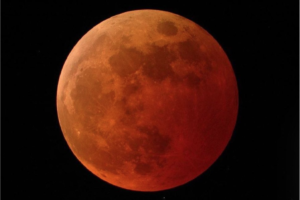
Photo: NASA
While the new year just began, Mother Nature already has an entire year’s worth of celestial events lined up for your viewing pleasure. The first major event will be a Super Blood Wolf Moon (say that 3X fast) which will occur on January 20th at 11 PM and the full lunar eclipse will begin around 11:41 PM. As NatGeo explained the best spots to view the eclipse will be from the Americas, Greenland, Iceland, western Europe, and western Africa. Sky-watchers in eastern Europe and eastern Africa will witness only the partial eclipse, while people in most of Asia will not see any part of the sky show. So what’s with the tongue twister name, Super Blood Wolf Moon? A “supermoon” means that the moon is at its closest point in its orbit to the earth and can appear 30% larger and 14% brighter than it does at its furthest point. A “blood moon” is another name for a lunar eclipse (because the moon appears red in color) and finally, as Cnet explained, January’s full moon is nicknamed the “wolf moon,” because cultures in the Northern Hemisphere used to sit around during the long winter nights and hear howling wolves outside–though this has been disputed.
Here is a list of other eclipses both lunar and solar that Forbes published:
- Total Solar Eclipse, July 2, 2019–visible from the South Pacific, Chile, hand Argentina
- Partial lunar eclipse, July 16, 2019–visible from Africa, Europe, and Asia
- Transit of Mercury (when Mercury passes in front of the moon), November 11, 2019– visible from U.S., Central America, and South America
- Annular Solar Eclipse, December 26, 2019– best visible in Saudi Arabia, southern India, northern Sri Lanka, the Indian Ocean, and Indonesia
Also, we can’t forget about meteor showers! Check out this list to see each season’s meteor shower and peak times to catch them.
Why This Matters: One of my (Miro’s goals) in 2019 is to visit more places where the night sky is dark enough to see stars and meteor showers. City life has its advantages but light pollution ensures that there’s no Perseid meteor shower viewing in DC. Last summer when I was visiting my family in California my mom and I sat outside and looked at the stars and it made me remember that enjoying the outdoors at night is its own unique experience. If you have plans this year to visit national parks (btw–many of which are still facing dire conditions as a result of the shut down) consider sticking around at night to do some stargazing. Here’s a list of the darkest spots in America to best see the night sky and if you want to take it a step further, here are the telescopes Popular Mechanics recommends for beginners. Happy gazing!
January 10, 2019 »


